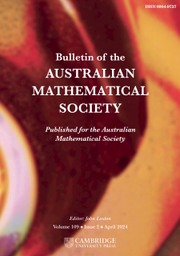No CrossRef data available.
Article contents
GROUPS HAVING 12 CYCLIC SUBGROUPS
Part of:
Representation theory of groups
Published online by Cambridge University Press: 26 August 2025
Abstract
A finite group is said to be n-cyclic if it contains n cyclic subgroups. For a finite group G, the ratio of the number of cyclic subgroups to the number of subgroups is known as the cyclicity degree of the group G and is denoted by  $\textit {cdeg} (G)$. In this paper, we classify all
$\textit {cdeg} (G)$. In this paper, we classify all  $12$-cyclic groups. We also prove that the set of cyclicity degrees for all the finite groups is dense in
$12$-cyclic groups. We also prove that the set of cyclicity degrees for all the finite groups is dense in  $[0,1]$, which solves a problem posed by Tărnăuceanu and Tóth [‘Cyclicity degrees of finite groups’, Acta Math. Hungar. 145(2) (2015), 489–504].
$[0,1]$, which solves a problem posed by Tărnăuceanu and Tóth [‘Cyclicity degrees of finite groups’, Acta Math. Hungar. 145(2) (2015), 489–504].
MSC classification
Information
- Type
- Research Article
- Information
- Copyright
- © The Author(s), 2025. Published by Cambridge University Press on behalf of Australian Mathematical Publishing Association Inc.
Footnotes
The first author would like to acknowledge the UGC-SRF grant, which is enabling her doctoral work.
References
Ashrafi, A. R. and Haghi, E., ‘On
 $n$
-cyclic groups’, Bull. Malays. Math. Sci. Soc. 42(6) (2019), 3233–3246.10.1007/s40840-018-0656-3CrossRefGoogle Scholar
$n$
-cyclic groups’, Bull. Malays. Math. Sci. Soc. 42(6) (2019), 3233–3246.10.1007/s40840-018-0656-3CrossRefGoogle Scholar
Belshoff, R., Dillstrom, J. and Reid, L., ‘Finite groups with a prescribed number of cyclic subgroups II’, Preprint, 2018, arXiv:1810.08328v1.10.1080/00927872.2018.1499923CrossRefGoogle Scholar
Belshoff, R., Dillstrom, J. and Reid, L., ‘Finite groups with a prescribed number of cyclic subgroups’, Comm. Algebra 47(3) (2019), 1043–1056.10.1080/00927872.2018.1499923CrossRefGoogle Scholar
Betz, A. and Nash, D. A., ‘Classifying groups with a small number of subgroups’, Amer. Math. Monthly 129(3) (2022), 255–267.10.1080/00029890.2022.2010493CrossRefGoogle Scholar
Das, A. and Mandal, A., ‘Solvability of a group based on its number of subgroups’, Preprint, 2024, arXiv:2403.01262.Google Scholar
Frobenius, G., Verallgemeinerung des Sylow’schen Satzes: Über auflösbare Gruppen II (De Gruyter, Berlin, 1895).Google Scholar
GAP Group, GAP—Groups, Algorithms, and Programming, Version 4.14.0 (5 December 2024). https://www.gap-system.org.Google Scholar
Hoang, N. S., ‘A limit comparison test for general series’, Amer. Math. Monthly 122(9) (2015), 893–896.10.4169/amer.math.monthly.122.9.893CrossRefGoogle Scholar
Jafari, M. H. and Madadi, A. R., ‘On the number of cyclic subgroups of a finite group’, Bull. Korean Math. Soc. 54(6) (2017), 2141–2147.Google Scholar
Kalra, H., ‘Finite groups with specific number of cyclic subgroups’, Proc. Math. Sci. 129(4) (2019), 1–10.10.1007/s12044-019-0490-zCrossRefGoogle Scholar
Lazorec, S. M., ‘A connection between the number of subgroups and the order of a finite group’, J. Algebra Appl. 21(1) (2022), Article no. 2250001, 20 pages.10.1142/S0219498822500013CrossRefGoogle Scholar
Meng, W. and Lu, J., ‘Lower bounds on the number of cyclic subgroups in finite non-cyclic nilpotent groups’, J. Math. Study 56(1) (2023), 93–102.10.4208/jms.v56n1.23.03CrossRefGoogle Scholar
Miller, G., ‘On the number of cyclic subgroups of a group’, Proc. Natl. Acad. Sci. USA 15(9) (1929), 728–731.10.1073/pnas.15.9.728CrossRefGoogle ScholarPubMed
Miller, G. A., ‘Determination of all the groups of order
 ${2}^m$
which contain an odd number of cyclic subgroups of composite order’, Trans. Amer. Math. Soc. 6(1) (1905), 58–62.Google Scholar
${2}^m$
which contain an odd number of cyclic subgroups of composite order’, Trans. Amer. Math. Soc. 6(1) (1905), 58–62.Google Scholar
Richards, I., ‘A remark on the number of cyclic subgroups of a finite group’, Amer. Math. Monthly 91(9) (1984), 571–572.10.1080/00029890.1984.11971498CrossRefGoogle Scholar
Roney-Dougal, C. M. and Tracey, G., ‘Subgroups of symmetric groups: enumeration and asymptotic properties’, Preprint, 2025, arXiv:2503.05416.Google Scholar
Sharma, K. and Reddy, A. S., ‘Groups having 11 cyclic subgroups’, Int. J. Group Theory 13(2) (2024), 203–214.Google Scholar
Tărnăuceanu, M., ‘Finite groups with a certain number of cyclic subgroups’, Amer. Math. Monthly 122(3) (2015), 275–276.10.4169/amer.math.monthly.122.03.275CrossRefGoogle Scholar
Tărnăuceanu, M. and Tóth, L., ‘Cyclicity degrees of finite groups’, Acta Math. Hungar. 145(2) (2015), 489–504.10.1007/s10474-015-0480-2CrossRefGoogle Scholar
Tóth, L., ‘On the number of cyclic subgroups of a finite Abelian group’, Bull. Math. Soc. Sci. Math. Roumanie (N.S.) 55(103)(4) (2012), 423–428.Google Scholar
Zhou, W., ‘Finite groups with small number of cyclic subgroups’, Preprint, 2018, arXiv:1606.02431.Google Scholar


